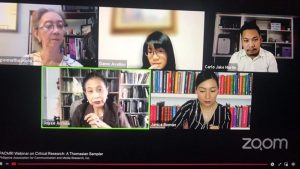Communication faculty members and alumni of the UST Graduate School served as resource speakers in the webinar titled “Critical Research: A Thomasian Sampler” held on September 29, 2021.

The speakers included UST Faculty of Arts and Letters and UST Graduate School faculty member Prof. Joyce L. Arriola, Ph.D., and three M.A. Communication graduates: Dame B. Avelino, Carlo Jake D. Martin, and Janice D. Roman. The webinar was organized by the Philippine Association for Communication and Media Research, Inc. (PACMRI), and was moderated by UST Faculty of Arts and Letters faculty member Prof. Maria Gwenetha Y. Pusta, Ph.D.
Arriola, in her introductory presentation “Critical Research: A Brief Primer,” traced the roots of critical research in communication and media studies, beginning with Aristotle’s Rhetoric, which is considered as the oldest communication theory, then linking it with the philosophy of St. Thomas Aquinas, and then with critical theories—both uppercase c (Critical Theory of the Frankfurt School) and lowercase c.
Explaining the connection between the webinar’s title and Thomism, Arriola highlighted that the Graduate School offers a course titled St. Thomas Aquinas on Critical Thinking, which teaches critical argumentation and reasoning.
Arriola underscored three frameworks and methods—transtextuality, genre study, and semiotics of space—to provide context for the research studies to be presented by the next three speakers.
Avelino’s presentation, “Utilizing Negative Capability and Paratextuality for Transmediation in The Grave Bandits (2012),” focused on the aforementioned film’s potential transmediation of media through negative capability, which referred to unanswered story details that can be used as entry points to another narrative, and transmedia geography, which pertained to other media that are not connected to the story of the main text.
This included social media such as Facebook and Twitter, reviews and criticism, promotional materials, and the like. Based on the analysis, characters were a huge fount of stories that could be used for narrative expansions. In addition, making use of social media for the film’s transmedia geography prior to its release allowed The Grave Bandits to build a solid audience following.
Using Digital Media Archaeology as a two-fold theory and methodology, Martin’s “Filipino Romantic Comedy Genre: A Study Through the ABS-CBN Film Archives” explored how the ABS-CBN Film Archives, the country’s de facto film repository, lend insights to the evolving digital archive-based scholarship. It employed archival research to survey the recurring genres of surviving Filipino films through the media giant’s film database site, the Film Archives Catalog System (F.A.C.S.).
The (digital) archival data showed that there is a significant uptick of Filipino romantic comedy films in terms of production in the early 2000s to 2010s, as compared to other leading genres and sub-genres. From there, this study delved deeper into the structuralist orientation of Filipino romantic comedy. By using Rick Altman’s Semantic/Syntactic Approach to Film Genre, six Pinoy ‘rom-coms’ are examined according to characters, settings, theme, and plot.
The results gathered from the genre and textual analyses revealed that while Filipino rom-coms agree with the present conditions of their Western counterparts, they also showcased tropes central to Filipino values, customs and traditions like panliligaw (courtship), harana (serenading) and pamamanhikan (asking the woman’s family for her hand in marriage).
The last presentation, “Hari ng Tondo: The Convergence of Hero and Place in Selected Fernando Poe, Jr.’s ‘Tondo’ Films” by Roman, analyzed seven Fernando Poe, Jr. (FPJ), films: Ito ang Maynila (1963), Tundo: Isla Puting Bato (1977), Tatak ng Tundo (1978), Iyo ang Tundo, Kanya ang Cavite (1986), Dito sa Pitong Gatang (1992), Eseng ng Tondo (1997), and Pakners (2003).
Roman showed how Tondo constructs FPJ as an iconic hero by utilizing the concepts of Joseph Campbell’s Monomyth, Andre Bazin’s Cinematic Realism, Edward Soja’s Trialectics of Space, and Roland Barthes’s Semiotics. According to her, the FPJ character encountered conflicts brought by the social realities and domestic affairs in Tondo. The character started out as an ordinary man, but these conflicts transformed him into a heroic character. From there, convergence occurred between the hero and the place.
PACMRI is an organization composed of Filipino researchers on communication and media of which Arriola is currently its Director of Research. Avelino is the PACMRI Luzon Area Coordinator for Research and the Communication Program Chair of the Angeles University Foundation, Angeles City. Martin is the Executive Officer of the Public Affairs and Information Services Department of the Quezon City Government. Roman is the Managing Editor for Higher Education at the C & E Publishing, Inc., and Special Lecturer at the Lyceum of the Philippines University-Manila.




